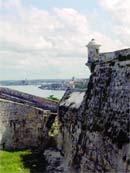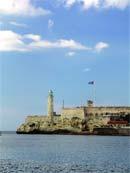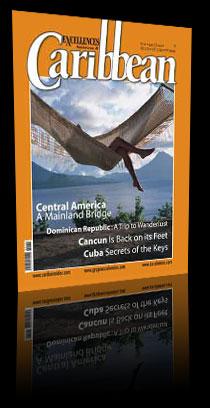Hilltop Castles world heritage in the caribbean
Three monumental works built in Cuba and Puerto Rico’s San Juan have been bestowed with the World Heritage category. They are the Morro (Hilltop) Castles. Their histories began somewhere near the discovery of the New World, during the Spanish colonial rule, with a view to provide protection for the new American colonies. Their identities –the result of a large-scale defensive scheme for the entire Caribbean region- are the main attributes that eventually gave them this universal condition in 1982.
In the last quarter of the 20th century, the world witnessed an awareness period toward historical and cultural values, as well as the promotion of their rescue and conservation. New expectations and potentials for the advance of cultural tourism arose. This marked the beginning of an era in which the United Nations Cultural, Educational and Scientific Organization (UNESCO) joined hands with the World Heritage Convention and managed to give this distinction to a good chunk of the region’s fortresses.
The Castle of the Three Kings of El Morro in Havana (1589), San Pedro de la Roca del Morro in Santiago de Cuba (1638) and San Felipe del Morro in Puerto Rico’s San Juan (1591) are all fortresses that have outlived time and stand tall in exceptionally beautiful landscapes and environments.
Cuba and Puerto Rico boast these flagship fortifications built atop huge rocky knolls called morros (hills) in Spanish –the term they are all named after. Morro means tall crag or rocky outcrop, usually isolated and near the shore.
When these fortresses were built, Havana, Santiago de Cuba and San Juan were still small trade-bustling and underdeveloped cities. The Morros were buildings that needed to be on the front burner; so therefore, they were the first ones to be rock solid and monumentally huge. That explains why they now rub elbows with other religious, civil, industrial and domestic constructions of similarly meaningful values.
The castles were built in the right places to chase the enemy away, face them off and defend these cities from the attacks of corsairs and pirates. The height of the hill or crag was the main checkpoint to get in touch with other fortresses and send warning signals. They used to be built at the entrance of bag-shaped bays, cashing in on their narrow entries and wide coves, large and deep enough to accommodate a good deal of deep-draft ships.
The opposite side of the narrow canal usually held a second, much smaller fortress in an effort to cut through incoming vessels in the crossfire. A thick chain protected the entrance. Today, those seaports are as important as they were in the past. Jaw-dropping freighters, oil tankers and fabulous cruise liners sail in and out, leaving these cities behind that have been heightened by their history, their music and dances, their popular songs and other cultural elements.
History has also left their footprints in the name Antonelli, an illustrious family of Italian military engineers who served the King of Spain, Felipe II. Juan Bautista Antonelli stayed in the Peninsula, while his brother Bautista Antonelli moved out to the Caribbean to start out a building endeavor that he handed down to his son Juan Bautista and his nephew Cristobal de Roda. They build these magnificent masterpieces called the Morros. Like other military engineers, they sacrificed their families and their homelands for most of their lifetimes to construct monumental works in the Caribbean, especially in Cuba and Puerto Rico.
Havana’s extraordinary bay and geographical location –right at the entrance of the Gulf of Mexico- made Cuba’s capital thrive as a transit point for the Spanish commercial fleet before sailing back to Europe. Plentiful wealth used to pile up at the Havana seaport for months until all the vessels arrived following their usual trip down La Guaira, Puerto Cabello, Santa Marta, Cartagena de Indias, Panama, Chagre, Portobelo and Veracruz. Shiploads of gold, silver, precious gems and unfathomable treasures were protected by the city. That traffic turned Havana in one of the most important colonies of the Americas and one of the best-fortified burgs of the New World.
Santiago de Cuba, on the southeastern side of the island nation –bathed by the choppy and deep waters of the Caribbean Sea- also grew as a major place. Its location prompted the departure of countless expeditions toward other American lands, including Hernan Cortes and his entourage to Mexico for the conquest of the ancient Aztec Empire. On the other hand, its excellent bay allowed the entry of the fleet’s vessels and the export of copper on a regular basis. Exports of this metal had begun there since the late 16th century.
Puerto Rico didn’t acquire the same level of Havana, though it did become a dominant strategic point. The island was close to the smaller Lesser Antilles, had access to the fleet and panned out to be a commercial route. Therefore, San Juan was a mandatory stopover point for the Spanish fleet for the exchange of goods, the reloading of drinkable water, tropical foodstuffs and other produce, as well as utensils needed to sail on.
The initial projects for the castles were inspired in modern building designs and techniques that had been applied in Italy during the Renaissance Period and during the firearm revolution. The sketches of these three fortresses were all similar: monumental and polygonal. Auxiliary batteries used to be set up just a few yards above sea level, like the ones over La Estrella and Los Doce Apostoles in Havana, the Santisimo Sacramento in Santiago de Cuba, and La Flotante in Puerto Rico. Some of these batteries rendered worthless because they were subject to the ruthless roughness of the sea.
Its interiors were dynamic. The guards used to move around over ramps, ladders and mazes leading up to the batteries and platforms –some of them carved in the rocks. The solid walls used to protect the barracks, the warehouses, and powder kegs, the church, the houses of the priests and the castle commander, the on-duty outposts, the ammo compartments and the prison cells.
The wells were equally important. Water used to be contained in these huge deposits in order to hold back the siege. Army men could not stand isolation without water. A multitude of channels for the circulation of rainwater –including small cisterns to purify it- were the means used as drainage systems and for the collection of the precious liquid.
Stones dug out of the coastlines and nearby quarries were the building material of choice to raise the walls. The stones used to be cut in square pieces called keystones.
The quarrymen used to mark each and every keystone with a symbol, so that they could get paid for the job done. Masonry was also used for the inner walls, with smaller stones that were glued together with mortar –a mixture of lime, sand and water- used in ancient constructions. Woodworks were reserved for balustrades, fixed ramps and drawbridges, windows, doors and stockades, while railings and portcullises were made of iron.
The 18th century was characterized the struggle of Spain against Great Britain’s expansionist policy. The British storming of Havana in 1762 was a token of that power’s huge human and defensive might. That development justified the military strengthening of Caribbean-based Spanish colonies, as well as the investment of heavy financial resources and huge military mobilizations.
Ambitious fortification projects were implemented at a large scale in the second half of that century. Improvements in artillery and the Navy brought about sea changes in the layout and concept of fortress making. The defense of Cuba and Puerto Rico were enhanced and streamlined to the utmost, and the Morro Castles were transformed to become far more solid and fit to meet the new military strategy of the times.
Technological breakthroughs of the 19th century also had its own ripple effects on the castles that eventually became auxiliary strongholds for advanced systems and started acting as warehouses and jailhouses for a number of years.
Today, these fortresses bring back memories of history and independence struggles in both Cuba and Puerto Rico Spain’s last two colonies in the Americas. Architecture is presented as an expression of the human endeavor to protect economic, commercial and territorial interests, while nature serves as an indispensable resource to deploy a well-calculated military strategy mapped out by celebrated military sages.




































































